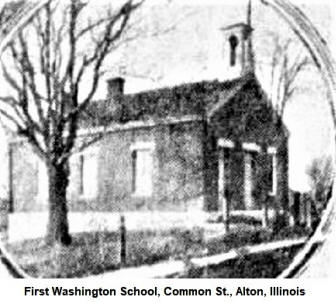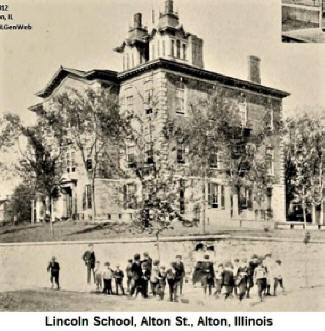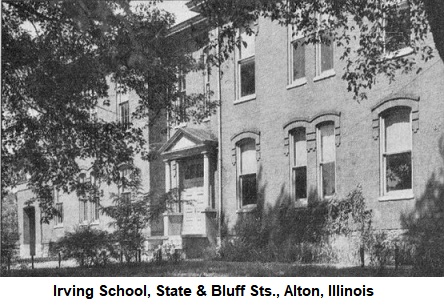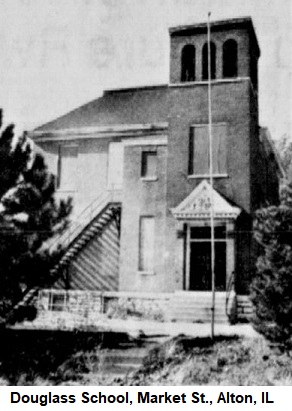Alton Township Schools
Alton Schools Newspaper Articles
THE FIRST PRIVATE SCHOOLS IN ALTON
The first schools in Alton were private schools that required
payment. In 1836, Miss Martha O. Dunn opened a school in the vestry
of the Presbyterian Church, where reading, spelling, defining and
writing, geography, grammar, history, arithmetic, drawing,
philosophy, astronomy, rhetoric, and composition were taught for
$15.00 per quarter. Another school was held in the Baptist Church,
with Miss Brown as teacher. There the students learned spelling,
reading, writing, geography, arithmetic, grammar, history,
astronomy, and philosophy for $7.00 per quarter. Other private
schools opened, such as a school for young ladies in Middletown,
taught by Miss Sophia Loomis in 1837; a female school in a stone
building at Market and Broadway, taught by Miss Mary P. Rand in
1838; a school taught by Mr. and Mrs. D. A. Richardson for both boys
and girls in Middle Alton, in 1842.
PUBLIC SCHOOLS IN ALTON
In 1837, the State Legislature granted the city of Alton a charter
which provided for the establishment of free public schools.
Meetings were held in 1837 to discuss the building of a school, but
no action was taken at that time. A free school was established in
the former Methodist Episcopal Church. In May 1842, a meeting was
held to discuss establishing a second school for the lower part of
District No. 2. It was decided to establish a free school in a frame
building known as Manning's House, above Hunter's Spring. The
students were to furnish their own desks and seats. A free school in
District No. 1 was established in 1842 in "the old courtroom" (Riley
building, southwest corner of Broadway & Alby Street).
Schoolhouse No. 2 (Name after the Ward it was in.)
While meetings were held as early as 1837 regarding building a
schoolhouse, it was not until July 1843 that any action was taken by
the City Council. At that time, $100.00 was appropriated to
purchased land in Pope's Addition. In 1845, the first free public
schoolhouse was constructed on Alton Street. It was a 2-room brick
schoolhouse, which cost $590.35. The schoolhouse was thirty feet
square, with twelve-foot walls. It was surrounded by a fence. The
first teacher was Rev. L. S. Williams, a returned missionary, and
opened in September 1845. Those who were unable to pay tuition for
their children were advised that they could obtain provision from
the city of Alton. Thirty-six students were present on the first
day. Rev. Williams, upon an occasion
 when
he had to correct an unruly student who had thrown an inkstand at
the head of his teacher, gave the youngster a "taste of the birch,"
and then knelt down and prayed over him, tears streaming from his
eyes. It was a scene long remembered. When Rev. Williams retired,
Mr. W. F. Guernsey replaced him. Guernsey taught for several years,
then returned to the East for his health. A school report, in
September 1846, stated that the first year of school ended with
about 81 students. As the population grew, a 1-room frame addition
was constructed. In the early days of Alton, the schoolhouses were
named after the Ward they were in. Consequently, the first
schoolhouse was named No. 2, even though it was the first public
school. A school report in 1858 stated that the school was called
the "Central School," and looked old and sere (threadbare or worn),
although the location was beautiful and was in a central position of
the city. In May 1866, Schoolhouse No. 2 was razed, and Lincoln
School was erected in its place.
when
he had to correct an unruly student who had thrown an inkstand at
the head of his teacher, gave the youngster a "taste of the birch,"
and then knelt down and prayed over him, tears streaming from his
eyes. It was a scene long remembered. When Rev. Williams retired,
Mr. W. F. Guernsey replaced him. Guernsey taught for several years,
then returned to the East for his health. A school report, in
September 1846, stated that the first year of school ended with
about 81 students. As the population grew, a 1-room frame addition
was constructed. In the early days of Alton, the schoolhouses were
named after the Ward they were in. Consequently, the first
schoolhouse was named No. 2, even though it was the first public
school. A school report in 1858 stated that the school was called
the "Central School," and looked old and sere (threadbare or worn),
although the location was beautiful and was in a central position of
the city. In May 1866, Schoolhouse No. 2 was razed, and Lincoln
School was erected in its place.
Schoolhouse No. 3 (Original Garfield School)
The second schoolhouse erected in Alton was in 1851, at the corner
of Fifth and Langdon Streets, in "Fountain or Mechanics Square"
(also known as "Seminary Square." It was named Schoolhouse No. 3,
after the Ward 3. This schoolhouse was a large, two-story brick
building, and was the second schoolhouse erected by the city of
Alton, and cost about $2,000 or $2,500. Although the city owned the
entire block, little had been done to the grounds. There was not a
tree or shrub on the entire square. In the back of the schoolhouse
was a large sunken depression in the ground, which filled up with
water during rainy times, making a dead pool. Later this school was
named the original Garfield School.
Schoolhouse No. 1
The third schoolhouse erected in Alton in 1851, and was located in
Ward 1 on State Street. It was called Schoolhouse No. 1. The school
opened in January 1852, with Mr. W. F. Gurnsey as Principal. The
building was two stories with a basement, and could hold about 150
students. In 1862, a visit was made to Schoolhouse No. 1, where
three departments were in successful operation. The "little wee
ones" were in the basement, with Miss Carpenter as teacher. The
average number of this department was 30 students. The second
department consisted of about 40 students, with Miss Hazzard as
teacher. The third department was taught by Mr. Waterman, and had 42
students. In 1883, Irving School was erected on this property.
First
High School in Unitarian Church
In 1855, an "advanced school," or high school, was opened in the
basement of the Unitarian Church, at the northeast corner of Third
and Alby Streets. James Newman was the first principal. In 1862, a
visit was made to the school, and found Mr. Adams and Mrs. B. Newman
as teacher.
Schoolhouse
No. 4 (Washington School, Common Street)
In 1856, a four-room schoolhouse was erected in Ward 4 on Common
Street, between East 16th Street and Euclid Place. This was first
named Schoolhouse No. 4, but later known as Washington School. It
cost $20,000. A visit was made to the schoolhouse No. 4 in 1862, and
found Misses Chickering and Pleace were teachers. This schoolhouse
was used until 1896, when a new Washington School was constructed on
Minor Street. This building was used as a mission school for a
while.
Schoolhouse No. 5
In 1856, Alton’s second schoolhouse, designed by architect Lucas
Pfeiffenberger, was erected in Ward 5 in the Hunterstown area of
Alton, on the northwest corner of Central Avenue and Sixth Street.
This was named Schoolhouse No. 5 (after the Ward it was located in),
and was renamed Humboldt School in May 1884, possibly after
Alexander Von Humboldt, the German natural scientist. Each room in
the two-story building was furnished with a blackboard on the wall,
with recessed bookcases. There were three large windows in each room
which furnished light. In the upper story, the four rooms were
separated by a sliding panel door, which could be opened to make two
rooms. At first, it was intended to use only the eastern half of the
schoolhouse, and a furnace was installed only in the eastern half.
It was necessary, however, to use one of the rooms in the western
half of the building, and an iron stove was installed to heat that
room. The lot was nicely graded with a brick walk in the front. In
the basement were two large playrooms for use during rainy or cold
weather.
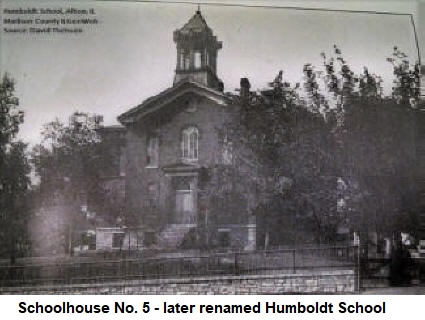
First African-American Schoolhouse
A school for African - American students existed as early as May
1858, although it is unknown where it was located. It was taught by
Mr. John Robinson, and adopted as a city school by the Alton City
Council. In May 1858, the school held a celebration of May Day.
Between 11 - 12 o'clock, they students, teacher, and guests walked
to a grove between Alton and Upper Alton, on the bank of Shield's
Branch, where they crowned a "Queen of the Day." (Shields Branch ran
from Rock Spring Park to the Mississippi - this grove may have been
at Rock Spring Park.) Students held their recitations, and then were
allowed to play in the nearby woods and green fields. Mr. Hardin was
called to then preside over a meeting, and Mr. C. C. Richardson was
introduced as the speaker. He addressed the subject of the
importance of education. The children then sang, and Mr. R. J.
Robinson addressed the audience. They then passed resolutions,
giving heartfelt thanks to the Alton Mayor and members of the City
Council for their unanimous decision in making the school a city
school.
Lincoln
School
Work began in May 1866 to erect the Lincoln School on Alton Street,
between Tenth and Eleventh Streets - where the first Alton
Schoolhouse No. 2 had been located. Lincoln was officially opened
February 4, 1867. The school building cost about $40,000. Lincoln
School was a three-story building, and had 12 classrooms, and at the
time of construction, it was considered one of the finest public
schools in the State. The high school students were moved from the
basement of the Unitarian Church to the third floor of this
building.
Humboldt School
In 1879, Humboldt School was erected where Schoolhouse No. 5 stood,
on the corner of Central Avenue and Sixth Street. It cost $10,000,
and had eight rooms.

Irving School
In March 1883, Irving School was erected on State Street, where
Schoolhouse No. 1 had been located.
Second Garfield School
In 1891, a new Garfield School was constructed on Sixth Street, on
the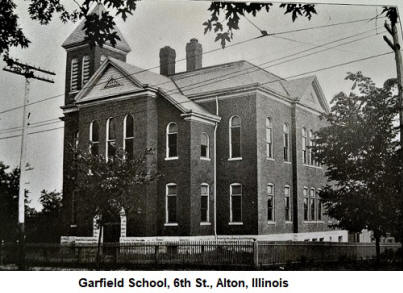 north side of Seminary Square. Plans were drawn up by Architect
Lucas Pfeiffenberger and Mr. Louis Seibert, of the Theo C. Link
Architect firm, which supervised the erection of the new Monticello
Ladies Seminary in Godfrey. The new Garfield School was two stories
high, 62 x 69 feet, with a basement, and a tower, 76 feet high. The
basement would hold two large playrooms for the students, during
stormy weather. The first floor contained a wide hall in the center,
with a classroom, 26 x 38 feet, on each side. There were also cloak
rooms, and a janitor's room. The second floor contained two
classrooms, two cloak rooms, a teacher's room, and a storage room.
Mr. Charles F. Degenhardt had the contract for the construction of
the building, with an cost of $18,000. The schoolhouse opened in
August 1891, with about 3,000 - 4,000 attending the large ceremony.
The Standard Band played at the ceremony, which had over 500
children in attendance.
north side of Seminary Square. Plans were drawn up by Architect
Lucas Pfeiffenberger and Mr. Louis Seibert, of the Theo C. Link
Architect firm, which supervised the erection of the new Monticello
Ladies Seminary in Godfrey. The new Garfield School was two stories
high, 62 x 69 feet, with a basement, and a tower, 76 feet high. The
basement would hold two large playrooms for the students, during
stormy weather. The first floor contained a wide hall in the center,
with a classroom, 26 x 38 feet, on each side. There were also cloak
rooms, and a janitor's room. The second floor contained two
classrooms, two cloak rooms, a teacher's room, and a storage room.
Mr. Charles F. Degenhardt had the contract for the construction of
the building, with an cost of $18,000. The schoolhouse opened in
August 1891, with about 3,000 - 4,000 attending the large ceremony.
The Standard Band played at the ceremony, which had over 500
children in attendance.
Douglass School
In 1897, Douglass School, for African-American students, was opened
on Market Street, between E. 9th and E. 10th Streets. It was named
after Frederick L. Douglass, one of the most intellectual
African-Americans of his generation. It cost $10,000. The principal
was Miss Fanny Barbour (sister to Florence Barbour, principal of
Lovejoy School), with Georgia Foxx as teacher.
Lovejoy School
In 1897, Lovejoy School, for African-American students, was erected
on the corner of Union and Silver Streets. It was named after Rev.
Elijah P. Lovejoy - a martyr of the cause of human freedom. It cost
$10,000. The principal was Miss Florence Barbour. Florence died in
July 1918, after surgery to remove a goiter in her neck. She was a
highly successful instructor and principal, and one of the best
known African-American women in Alton at the time.
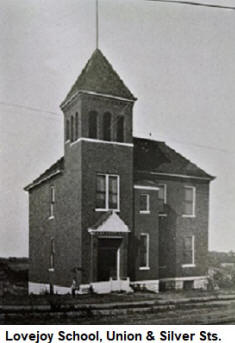
Washington School, Milnor Street
In 1896, the neighborhood of Highland Park was added to the city of
Alton. Washington School was erected at 929 Milnor Street.
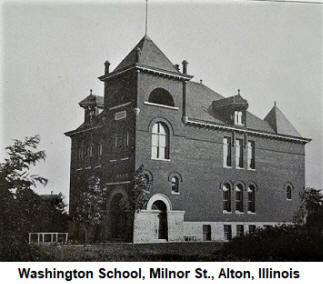
Lowell School
On February 26, 1900, Lowell School in Alton was officially opened
on Joesting Avenue (off of Washington Avenue). It was named in honor
of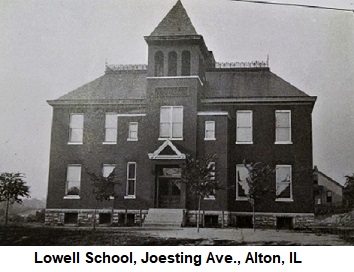 James Russell Lowell, an American statesman-poet. The four-room
building cost $8,542, and was planned by architect Lucas
Pfeiffenberger. Henry Schuelle was the contractor. The first
principal was Mr. Terry, with Miss Hartman and Miss Kuhn as
teachers. Most of the students transferred from Humboldt School, but
a number of them resided in Yaeger Park. In 1915, the grounds of
Lowell School were enlarged through the purchase of property from
the Illinois Glass Company. This gave the students more room for
their playground. The school closed in about 1975, and has since
been razed.
James Russell Lowell, an American statesman-poet. The four-room
building cost $8,542, and was planned by architect Lucas
Pfeiffenberger. Henry Schuelle was the contractor. The first
principal was Mr. Terry, with Miss Hartman and Miss Kuhn as
teachers. Most of the students transferred from Humboldt School, but
a number of them resided in Yaeger Park. In 1915, the grounds of
Lowell School were enlarged through the purchase of property from
the Illinois Glass Company. This gave the students more room for
their playground. The school closed in about 1975, and has since
been razed.
McKinley – Roosevelt High School
In 1902, the William McKinley High School - the first school
dedicated to high school students - was erected in Seminary Square,
just West of Garfield School, on E. 6th Street. It was named after
President William McKinley, who had recently been assassinated.
McKinley High School was dedicated November 20, 1902. In 1919,
McKinley High School was renamed the Theodore Roosevelt High School,
following the death of the President in January 1919. The architect
for the new high school was J. W. Gaddis. It was the first Alton
school to have showers for students who "undergo violent exercise."
During the construction of the high school, contractors
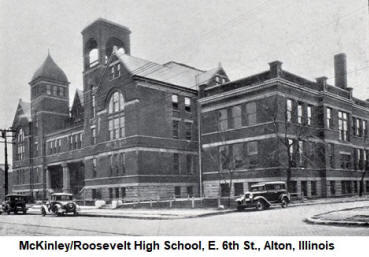 had
problems finding solid ground to lay concrete foundations. they went
down 20 feet, and were still throwing out old tin cans and other
trash, indicating they had not reached the bottom of fill dirt. The
cornerstone was finally laid in June 1902, with a large ceremony
accompanying. McKinley had the first high school orchestra. In 1904,
teacher and students raised money for a new gymnasium at the school.
In 1905, "The Tatler," a publication by the Junior class of McKinley
School, made its debut. In 1905, Alton schools received telephones
in every school building for the first time. In 1906, for the first
time in history, a high school student - David Harry Prince - was
married. In 1908, the new high school paper - "The Piasa Quill" -
was released. In 1912, the bell from the Lincoln School was moved to
McKinley High School, in order to relieve the aging Lincoln School
roof from so much weight. In 1919, after McKinley was renamed
Roosevelt High School, a new cafeteria and kitchen was opened at the
school. It was located in the basement. All portions were five
cents, and a suitable lunch could be had for 10 to 25 cents. In
1920, high school students battled against the high cost of
clothing, such as overalls, by attending school in old clothes.
Girls wore calico dressed and other clothing noted for plainness. In
August 1920, the M. H. Boals house, located at Sixth and Langdon
Streets, was purchased by the Board of Education for $11,000. the
building was to be used for classes of the commercial department at
the Roosevelt High School. In 1921, students began receiving credit
for Bible classes.
had
problems finding solid ground to lay concrete foundations. they went
down 20 feet, and were still throwing out old tin cans and other
trash, indicating they had not reached the bottom of fill dirt. The
cornerstone was finally laid in June 1902, with a large ceremony
accompanying. McKinley had the first high school orchestra. In 1904,
teacher and students raised money for a new gymnasium at the school.
In 1905, "The Tatler," a publication by the Junior class of McKinley
School, made its debut. In 1905, Alton schools received telephones
in every school building for the first time. In 1906, for the first
time in history, a high school student - David Harry Prince - was
married. In 1908, the new high school paper - "The Piasa Quill" -
was released. In 1912, the bell from the Lincoln School was moved to
McKinley High School, in order to relieve the aging Lincoln School
roof from so much weight. In 1919, after McKinley was renamed
Roosevelt High School, a new cafeteria and kitchen was opened at the
school. It was located in the basement. All portions were five
cents, and a suitable lunch could be had for 10 to 25 cents. In
1920, high school students battled against the high cost of
clothing, such as overalls, by attending school in old clothes.
Girls wore calico dressed and other clothing noted for plainness. In
August 1920, the M. H. Boals house, located at Sixth and Langdon
Streets, was purchased by the Board of Education for $11,000. the
building was to be used for classes of the commercial department at
the Roosevelt High School. In 1921, students began receiving credit
for Bible classes.
History of the Western Military Academy
